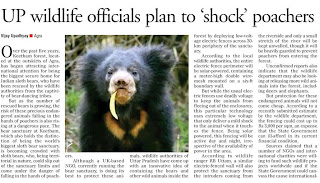UP wildlife authorities wake up to vanishing gharials
Vijay Upadhyay
Agra. The ecological balance of a river is largely dependent on the presence of predator and scavengers like crocodiles and other similar creatures. While crocodiles are largely found in the rivers of South India, the northern and eastern rivers in the country are solely dependent on gharials, a long-nosed relative of crocodiles that is purely riverine in its habitat.
Lately, with an increase in pollution in the Ganga and the Yamuna rivers, the gharials have completely vanished from these rivers, which has made these rivers full of decomposing fishes and rotting bodies of animals and humans to further pollute these rivers.
Now, in an effort to restore the ecological balance of the rivers in Uttar Pradesh, the Wildlife Authorities of the State are planning to introduce gharials, also called Gavialis Gangeticus, in the rivers.
A group of 56 gharials, brought from the Kukrail wildlife park in Lucknow were released by the wildlife authorities in the Chambal river near Pinahat in Agra on Friday as a step towards the rehabilitation of gharials in the river and to promote breeding of this reptilian creature in the river.
Talking to The Pioneer, KK Singh, Divisional Forest Officer (Wildlife), Chambal Range said that the Chambal wildlife sanctuary was a 180 km stretch of river passing through Uttar Pradesh, Madhya Pradesh and Rajasthan and being an unpolluted river flowing away from the urban population, it was the best location for the crocodilian species to breed and a number of other aquatic creatures like Gangetic dolphins and turtles, of which, atleast eight species were living in the river, almost all of whom were carnivorous, that helped in preservation of aqu-atic equilibrium in the river.
He said that the population of crocodiles in almost all the rivers of UP had decreased in the past few decades but in contrast to the other rivers, Chambal had a high concentration of crocodiles and adding more of this species in the river would ensure that some of these species move over to the Yamuna and other rivers connected to the Chambal river. He said that the gharials that had been released in the Chambal had been collected from the Chambal river in the form of eggs that were later hatched in the Kukrail Park at Lucknow and raised till the age of 4-6 years before they were finally rehabilitated.
He said that at present, there were atleast 3,000 gharials and almost 1,000 "Muggers" (Crocodylus Palustris) living in the Chambal river that had reproduced rapidly after the beginning of the Chambal National Park project in 1979. He said that the reason for collecting eggs of crocodiles from the river was to ensure the maximum hatching of the eggs through artificial incubation at the Kukrail Park in Lucknow as the crocodiles were listed in the first schedule of Wildlife Conservation Act 1972, as an endangered species and it was only through human interference in their breeding cycle that they had been able to regain their numbers in the polluted rivers of North India.


Comments